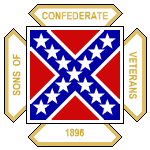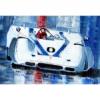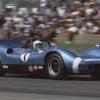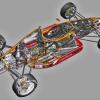That sounds like a very common, typical racing situation - no mysteries in this description of the accident.Originally posted by TrackDog
...As I understand the sequence of events, Dave was almost beside Hansgen coming out of the turn, and travelling about 10 mph faster. He drove down inside Walt, who couldn't see him; and Walt moved down on him, unwittingly. MacDonald had to veer to the left suddenly to keep from hitting Hansgen, and the sudden swerve broke the rear end loose...Dan
[Edit]On second thought, strike that question. MacDonald's speed may have been due to the light fuel load.
In lieu of film, there is Len Sutton's eyewitness account from the "best" vantage point—from inside the car following these two—which is found here:Originally posted by Henri Greuter
Dan,
I always understood that he was short behind Hansgen and was closing in so fast after coming out of the turn that he should have rear ended Walt had he not made the move to the left.
But I am not aware of any film footage existing (and available to the public for watching) of the cars coming out of the turns in which Dave was not spinning already.
That film footage taken from the air could answer that question.
But where is it?
Henri
http://forums.autosp...221#post2825221
[Edit]Here is Sutton's account:
In the second lap at the end of the back stretch, going into the third turn, Dave MacDonald went whistling by me, jumped on the binders and proceeded across the short chute in front of me. Walt Hansgen was right in front of him then and Dave drove it deep under him, but not deep enough for Walt to see him. when Hansgen came down, as that was his line, Dave had to get his nose out or turn left enough to keep from running into him.
Dave's back end got away from him and he headed for the inside guard rail. Anyone watching this unfold - and I was - could feel certain it was going to be tragic. By the time Dave's car was off the wall and heading back onto the track, I was just even with him and escaped down the front stretch.






















